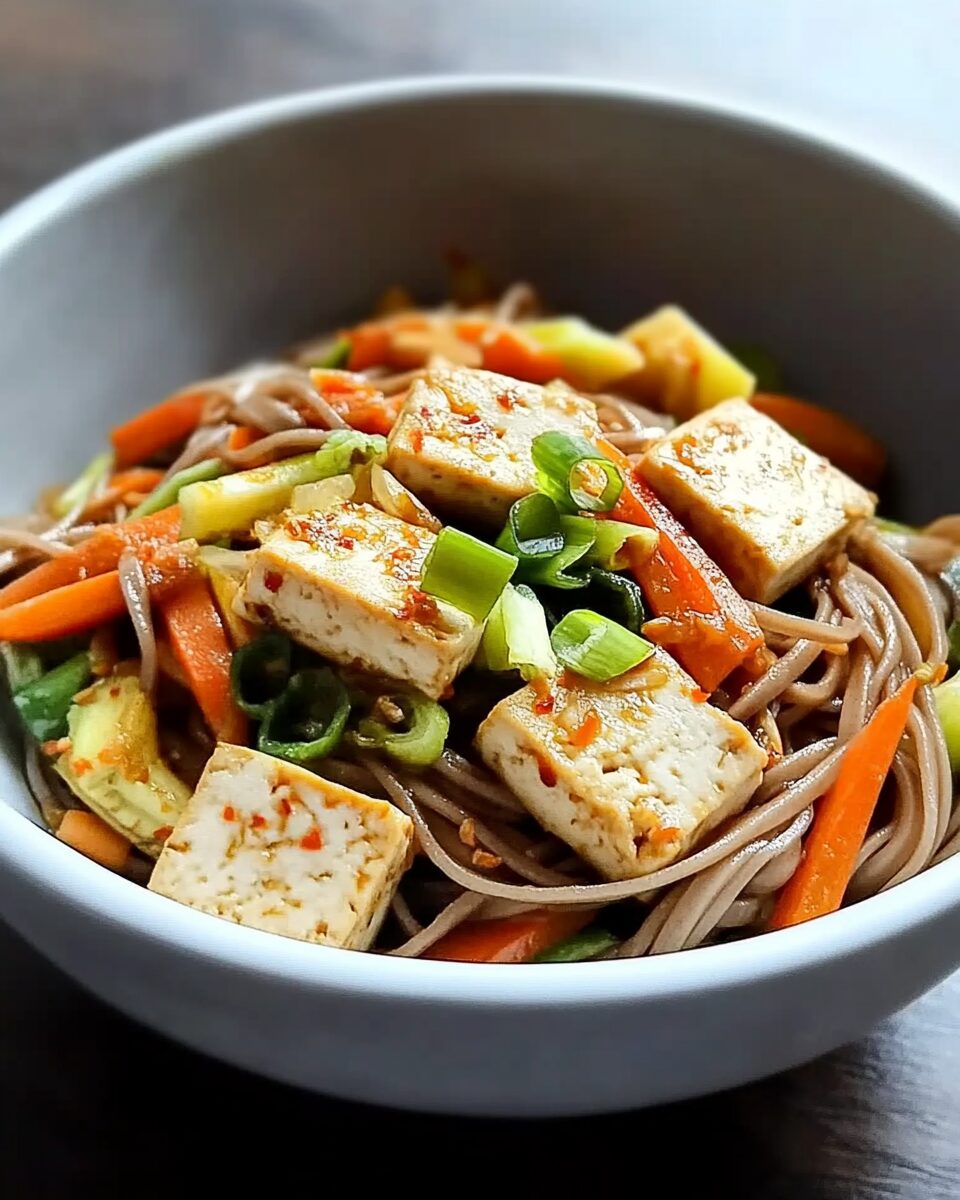Tamarind Tofu with Vegetables and Soba is a flavorful and satisfying dish that combines the bold, tangy flavors of tamarind with crispy tofu, colorful vegetables, and tender soba noodles. This Asian-inspired dish is a perfect blend of savory, sour, and slightly sweet, with a depth of flavor that comes from the tamarind sauce. It’s a vegan and gluten-free option that’s both hearty and healthy, making it ideal for a light lunch or dinner. Whether you’re a tofu enthusiast or just looking to try something new, this dish provides a unique and exciting way to enjoy plant-based ingredients.
Full Recipe:
Ingredients
- 1 block firm tofu, drained and pressed
- 8 oz soba noodles
- 1 tablespoon vegetable oil
- 1 red bell pepper, thinly sliced
- 1 zucchini, thinly sliced
- 1 carrot, julienned
- 2 tablespoons tamarind paste
- 2 tablespoons soy sauce
- 1 tablespoon maple syrup
- 1 tablespoon sesame oil
- 1 garlic clove, minced
- 1 teaspoon ginger, minced
- 2 tablespoons sesame seeds
- Fresh cilantro for garnish
Directions
- Begin by cooking the soba noodles according to the package instructions. Drain and rinse with cold water to stop the cooking process. Set aside.
- Cut the tofu into cubes and heat vegetable oil in a large skillet over medium heat. Add the tofu cubes and cook until golden and crispy on all sides, about 6-8 minutes. Once done, remove from the skillet and set aside.
- In the same skillet, add the red bell pepper, zucchini, and carrot. Cook for 3-4 minutes, or until the vegetables are tender but still crisp.
- In a small bowl, whisk together tamarind paste, soy sauce, maple syrup, sesame oil, garlic, and ginger to create the sauce.
- Add the cooked soba noodles and crispy tofu to the skillet with the vegetables. Pour the tamarind sauce over the mixture and toss everything to coat evenly.
- Cook for an additional 2-3 minutes, allowing the sauce to heat through and coat all ingredients.
- Serve the dish in bowls, garnished with sesame seeds and fresh cilantro.
Nutrients
- Calories: 330
- Total Fat: 18g
- Saturated Fat: 3g
- Cholesterol: 0mg
- Sodium: 480mg
- Total Carbohydrate: 33g
- Dietary Fiber: 4g
- Sugars: 8g
- Protein: 14g
The Origins of Tamarind and Its Role in Global Cuisine
Tamarind is a tropical fruit that grows on the tamarind tree, native to Africa but commonly found in many parts of Asia, including India, Thailand, and Vietnam. The fruit has a unique flavor profile that is both tangy and sweet, making it a popular ingredient in a variety of dishes worldwide. In Asian cuisine, tamarind is often used in soups, curries, stir-fries, and sauces due to its natural ability to enhance flavor and balance out savory and sweet notes.
In India, tamarind is a key ingredient in chutneys and dals, while in Southeast Asia, it is often used in dishes like Pad Thai, sour soups, and marinades. Its use in these cuisines highlights its versatility, as it can be paired with both savory and sweet ingredients to create complex, layered flavors. Tamarind is not only flavorful but also offers various health benefits, such as aiding in digestion and providing a good source of antioxidants.
The use of tamarind in this tofu dish brings a touch of authenticity and complexity to the meal, transforming it from a simple stir-fry into something special. The tangy flavor of tamarind pairs beautifully with the crispy tofu, vegetables, and soba noodles, making this dish both satisfying and full of depth.
Why Tamarind Tofu with Vegetables and Soba is a Perfect Choice
Tamarind Tofu with Vegetables and Soba stands out for several reasons, from its rich, layered flavors to its health benefits and ease of preparation. This dish is a great option for those seeking to eat healthier, plant-based meals without sacrificing taste. It provides a balanced combination of carbohydrates, protein, and healthy fats, making it a well-rounded meal.
One of the key attractions of this dish is its versatility. As mentioned earlier, you can swap the vegetables based on what’s in season or based on your personal preferences. Vegetables like bell peppers, broccoli, and snow peas would work well in this dish, offering a crunchy texture that contrasts nicely with the tender tofu and soba noodles. Additionally, the tamarind sauce can be adjusted to suit your taste. Whether you prefer a sweeter sauce or one that’s more tangy and spicy, the flexibility of this dish allows for customization.
Another reason this dish is so appealing is that it’s quick and easy to prepare. Soba noodles cook in just a few minutes, and tofu takes only a short time to pan-fry to a crispy texture. The sauce comes together quickly, making this a great meal option for busy weeknights or when you want to prepare a meal that doesn’t require too much time or effort. Despite its simplicity, the dish is full of flavor, offering the perfect combination of savory, sweet, and tangy.
Health Benefits of Tamarind Tofu with Vegetables and Soba
Tamarind Tofu with Vegetables and Soba is not just delicious but also packed with nutrients. Let’s break down the key health benefits of the dish’s ingredients:
-
Tofu: Tofu is a great source of plant-based protein, making it an excellent meat substitute for vegetarians and vegans. It is low in calories and fat but high in essential amino acids, which are vital for muscle growth and overall body function. Tofu is also rich in iron, calcium, and magnesium, minerals that are important for bone health and energy production. Additionally, tofu contains isoflavones, which are plant compounds that have been shown to have anti-inflammatory and antioxidant properties.
-
Soba Noodles: Soba noodles, made from buckwheat, are a nutritious alternative to regular wheat noodles. Buckwheat is gluten-free and rich in fiber, which helps promote healthy digestion and stabilize blood sugar levels. Buckwheat also contains essential vitamins and minerals, including manganese, magnesium, and copper, which contribute to heart health and help reduce inflammation in the body. The protein content in buckwheat makes soba noodles a good source of plant-based protein, and they are also a great source of complex carbohydrates, providing steady energy.
-
Tamarind: Tamarind is packed with antioxidants, which help protect the body’s cells from damage caused by free radicals. It is also a good source of vitamins and minerals, including vitamin C, potassium, and magnesium. Tamarind has been shown to aid in digestion and help improve liver function, making it a beneficial ingredient in many traditional health remedies. Additionally, tamarind can help lower cholesterol and support heart health.
-
Vegetables: The vegetables in this dish—cucumber, bell peppers, and carrots—provide a wealth of nutrients. Carrots are rich in vitamin A, which supports eye health, while bell peppers are an excellent source of vitamin C, an antioxidant that boosts immunity and promotes healthy skin. Cucumbers are hydrating and low in calories, making them a refreshing addition to the salad.
-
Sesame Oil and Soy Sauce: Both sesame oil and soy sauce contribute to the dish’s flavor and offer health benefits. Sesame oil is a good source of healthy fats, including monounsaturated fats, which support heart health and help reduce inflammation. It also contains antioxidants that have anti-inflammatory properties. Soy sauce provides a savory umami flavor and contains small amounts of protein, iron, and manganese.
Customization Options for Tamarind Tofu with Vegetables and Soba
One of the best features of Tamarind Tofu with Vegetables and Soba is its versatility. The recipe can easily be customized to suit your personal tastes, dietary needs, or whatever ingredients you have on hand. Here are a few suggestions for customizing the dish:
-
Protein Substitutes: While tofu is the main protein in this dish, you can substitute it with other plant-based proteins like tempeh, seitan, or even edamame for a change of texture and flavor. If you’re not vegetarian or vegan, you can add grilled chicken, shrimp, or beef for additional protein.
-
Vegetable Variations: The vegetables in this dish are flexible and can be swapped out based on your preferences or what’s in season. Try adding vegetables like mushrooms, bok choy, snow peas, or snap peas. You could also add leafy greens like spinach or kale for added nutrients.
-
Adjusting the Spice Level: If you prefer a spicier dish, add more chili oil or incorporate sliced fresh chili peppers into the salad. For a milder version, omit the chili oil or reduce the amount used in the dressing.
-
Alternative Noodles: While soba noodles are the traditional base for this dish, you can swap them with other noodles such as rice noodles, udon, or even zucchini noodles for a lower-carb option. Each type of noodle brings its own texture and flavor, so feel free to experiment.
-
Dressing Adjustments: The tamarind dressing can be adjusted to suit your taste. Add more maple syrup for a sweeter flavor or increase the soy sauce for a saltier, more savory kick. You can also experiment with adding a splash of rice vinegar for extra tang or a bit of peanut butter for a creamier texture.
Serving and Pairing Tamarind Tofu with Vegetables and Soba
Tamarind Tofu with Vegetables and Soba is a well-rounded meal that can be enjoyed on its own, but it can also be paired with other dishes for a more complete dining experience. Here are some great options for sides and beverages to serve with this dish:
-
Side Dishes: Serve the salad with a side of steamed edamame, miso soup, or grilled vegetables. These sides will complement the flavors of the salad while adding additional texture and nutrients.
-
Beverages: For a refreshing drink, consider pairing the dish with iced green tea, coconut water, or a citrusy limeade. If you prefer an alcoholic beverage, a light, crisp white wine such as Sauvignon Blanc or a cold beer like a pilsner would work well with the dish’s flavors.
-
Garnishes: To elevate the dish, consider topping it with more sesame seeds, fresh cilantro, or crushed peanuts for extra crunch and flavor.
Conclusion
Tamarind Tofu with Vegetables and Soba is a flavorful, vibrant dish that brings together the best of plant-based ingredients in a healthy and satisfying meal. The combination of crispy tofu, tender soba noodles, fresh vegetables, and tangy tamarind dressing creates a well-balanced dish that is as delicious as it is nutritious.






